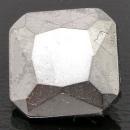|
|
||||||||||||||||
|
||||||||||||||||
|
||||||
|
|
|
|
Arsenopyrite
|
|
| | |
| Discovered in 1847; IMA status: Valid (pre-IMA; Grandfathered) | ||
|
| ||
|
Chemistry |
|
|
| |
|
FeAsS | |
|
|
Iron Arsenide Sulfide |
|
Molecular Weight: |
162.83 gm |
|
Composition: |
Iron |
34.30 % |
Fe |
|
|
|
|
Arsenic |
46.01 % |
As |
|
|
|
|
Sulfur |
19.69 % |
S |
|
|
|
|
|
100.00 % |
|
|
|
|
|
|
||||
|
Classification |
|
|
| |
|
Sulfides | |
|
2/D.22-10 | |
|
|
2 : SULFIDES and SULFOSALTS (sulfides, selenides,
tellurides; arsenides, antimonides, bismuthides; sulfarsenites,
sulfantimonites, sulfbismuthites, etc.) |
|
Related to: |
Arsenopyrite Group. Arsenopyrite is closely related to Alloclasite, but is not an exact analogue, because of different As-S and S-As ordering. |
|
Members of Group: |
Arsenopyrite Group: Arsenopyrite, Gudmundite, Osarsite, Ruarsite |
|
Varieties: |
Danaite |
|
Synonyms: |
Arsenical Iron, Arsenical Pyrites, Arsenomarcasite, Dalarnite, Plinian, Thalheimite |
|
|
|
|
Crystal Data |
|
|
|
|
|
Crystals, to 30 cm, flat tabular to blocky to prismatic, striated k [001]. Also compact, granular, columnar. |
|
|
Common on {100} and {001}; as contact or penetration twins on {101}; on {012} to produce star-shaped trillings or cruciform twins. |
|
|
|
|
|
Physical Properties |
|
|
|
|
|
Distinct on {101}; {010} in traces. |
|
|
Irregular/Uneven |
|
|
Brittle |
|
|
5.5 – 6.0 |
|
|
Vicker's Hardness: |
VHN100=1081 kg/mm2 |
|
6.07 (g/cm3) |
|
|
Not Fluorescent |
|
|
Not Radioactive |
|
|
Health Warning: |
CAUTION: Contains Arsenic, a poisonous element - always wash hands after handling. Avoid inhaling dust when handling or breaking. Never lick or ingest. |
|
|
|
|
Optical Properties |
|
|
|
|
|
Silver-white to steel-gray; in polished section, white with faint yellow tint. |
|
|
Opaque |
|
|
Metallic |
|
|
R1–R2: (400) 50.3–51.8, (420) 50.3–51.8, (440) 51.3–51.8, (460) 50.6–51.8, (480) 51.0–51.9, (500) 51.4–51.9, (520) 51.8–51.9, (540) 52.2–51.9, (560) 52.5–51.9, (580) 53.0–51.8, (600) 53.4–51.6, (620) 53.6–51.5, (640) 53.6–51.3, (660) 53.6–51.3, (680) 53.4–51.2, (700) 53.2–51.0 |
|
|
0.00 (opaque) |
|
|
n/a |
|
|
Weak; in white or bluish tint and faint reddish yellow. |
|
|
Strong; Color in reflected light: red-violet |
|
|
|
|
|
Occurances |
|
|
|
|
|
Geological Setting: |
Of hydrothermal origin, typically one of the earliest minerals to form. Found in pegmatites, high-temperature gold-quartz and tin veins, and in contact metamorphic sulfide deposits; less commonly of low-temperature hydrothermal origin. Also in gneisses, schists and other metamorphic rocks. |
|
Common Associations: |
Pyrrhotite, Pyrite, Chalcopyrite, Galena, Gold, Scheelite, Cassiterite, many other species. |
|
Common Impurities: |
Ag, Au, Co, Sn, Ni, Sb, Bi, Cu, Pb |
|
Type Locality: |
n/a |
|
Year Discovered: |
1847 |
|
View mineral photos: | |
|
|
|
|
More Information |
|
|
|
|
|
| |
|
|
|
|
Distribution:
The most abundant and widespread arsenic mineral; only
a few localities for large and fine crystals can be
mentioned. In Germany, from Altenberg, Ehrenfriedersdorf,
and Freiberg, Saxony. In the Stari Trg mine, Trepca,
Serbia. From Panasqueira, Portugal. At Sala, Tunaberg,
Stollberg, Boliden, and Nordmark, Sweden. From Stratonik,
Greece. In England, from a number of mines in Cornwall,
and in Devonshire, at Tavistock. In the USA, from Franconia,
Grafton County, New Hampshire and Franklin, Sussex County,
New Jersey. From Hidalgo del Parral and Santa Eulalia,
Chihuahua, Mexico. In Canada, in the Cobalt district,
Ontario. In Japan, large crystals in the Obira mine,
Bungo, Oita Prefecture; the Ashio mine, Tochigi Prefecture;
and many other localities. |
|
|
We
have not photographed our Arsenopyrite gems yet. Please
check back soon. |
